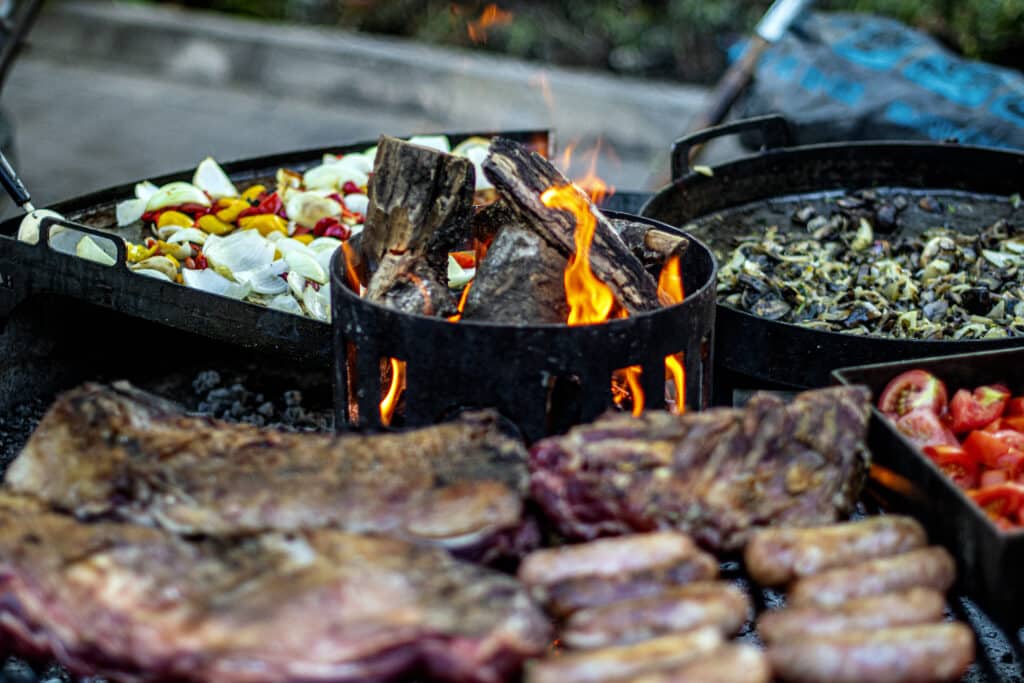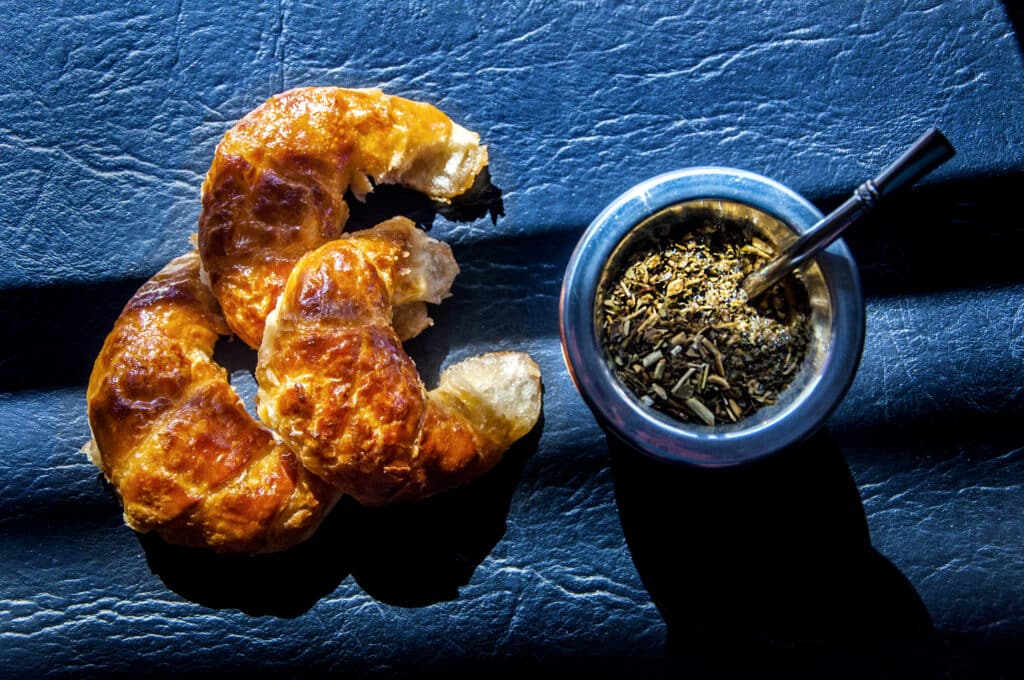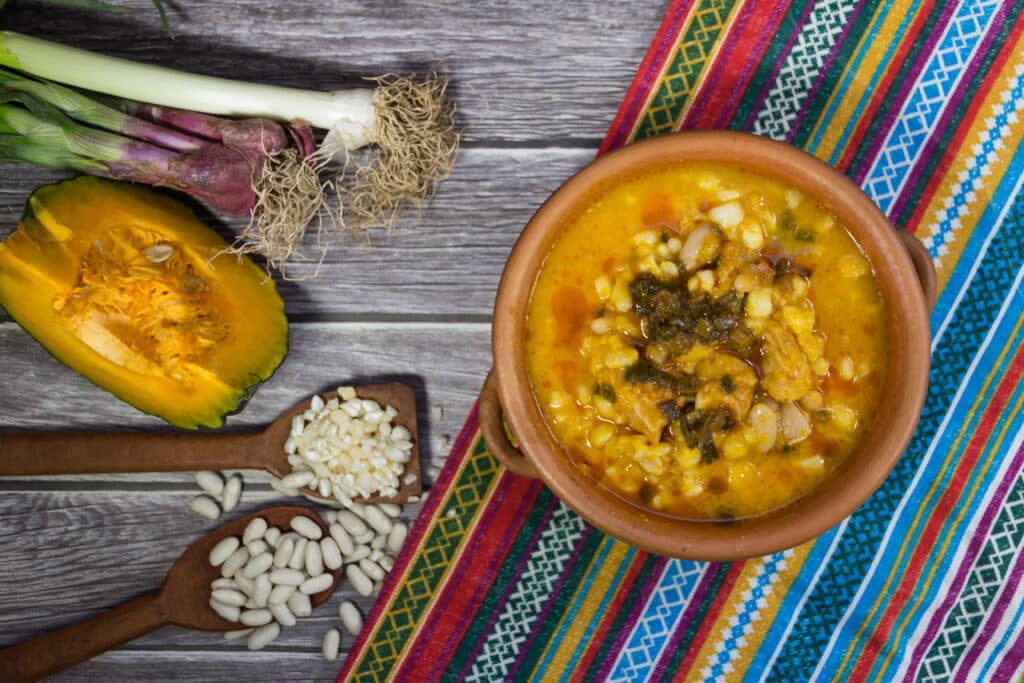In southern Latin America, Argentina offers a diverse and rich culinary landscape that reflects its European heritage and indigenous traditions.
From the bustling streets of Buenos Aires to the serene landscapes of Patagonia, Argentine dishes are a vibrant mix of flavors, ingredients, and culinary techniques.
Remitly created this post to explore the must-try traditional dishes that define Argentinian cuisine, emphasizing the fusion of Spanish, Italian, and indigenous influences.
The Heart of Argentine Cuisine: Grilled and Smoked
Asado: The National Dish
The cornerstone of Argentine cuisine is undoubtedly the asado, a barbecue-style cooking that’s more than just a meal; it’s a cultural ritual. Asado is also the national dish in neighboring Uruguay.
Slow-cooked over a parrilla (grill), asado typically features various cuts of meat, including flank steak and chorizo sausage, all richly seasoned with chimichurri sauce—a garlicky condiment made with olive oil, oregano, and other herbs.
This smoky feast is often enjoyed with a glass of robust Malbec, Argentina’s famed red wine, making it a quintessential South American culinary experience.

Choripán and Provoleta
Choripán, a simple yet delicious street food, combines crusty bread with juicy chorizo, topped with chimichurri.
It’s a favorite among locals, especially as an appetizer during an asado. Another grilled favorite is provoleta, a thick slice of provolone cheese seasoned with oregano and chili flakes, grilled until crispy and gooey.

Italian and Spanish Flavors
Immigration from Europe heavily influenced Argentina’s food traditions, especially from Italy and Spain, though many other culinary legacies have also come to Argentina’s shores—from French cuisine to Jewish staples of Eastern Europe.
Milanesa and Fainá
The Italian influence is strong in Argentine food, with dishes like milanesa—a breaded and fried meat cutlet, often topped with a fried egg or tomato sauce, resembling the Italian cotoletta.
Accompanying this dish might be fainá, a chickpea flour flatbread of Italian origin, reflecting the fusion of Italian and Argentine tastes.

Empanadas
Spanish cuisine has influenced contemporary nations from South America all the way to the Philippines. In Argentina, empanadas are a particularly famous Spanish legacy.
These pastries are filled with a mixture of ground beef, hard-boiled eggs, bell peppers, and spices, with regional variations.
They’re also popular in neighboring nations like Chile and Bolivia.

Medialunas
In the realm of Argentine pastries, medialunas hold a special place, particularly at breakfast or during the beloved mid-afternoon snack known as “merienda.”
These crescent-shaped pastries, whose name literally means “half moons,” are Argentina’s answer to the French croissants, showcasing the European influence, particularly from Italy and France, on Argentine cuisine.
Medialunas come in two main types: “de grasa” (made with lard) and “de manteca” (made with butter). Medialunas de grasa are usually smaller, crispier, and less sweet, making them perfect for savory pairings such as ham and cheese.
On the other hand, medialunas de manteca are larger, softer, and sweeter, often glazed with a sticky syrup.

Indigenous and Local Influence
Locro and Humita
Locro, a hearty stew made from corn, beans, sweet potato, and various meats including blood sausage (morcilla) and chorizo, is a testament to the indigenous and colonial culinary blend.
Humita, on the other hand, is a dish made from fresh corn, cheese, and spices, wrapped in corn husks and steamed, offering a sweet and savory flavor that is uniquely South American.

Carbonada: A Creole Innovation
In the colder regions, especially in Patagonia, carbonada is a popular choice.
This stew contains meat, potatoes, sweet potatoes, and a surprising addition of quince, offering a sweet contrast to the savory ingredients, typically served in a hollowed-out gourd, highlighting the rustic, earthy elements of Argentinian food.
Matambre
The word “matambre” is a portmanteau derived from the Spanish words “matar” (to kill) and “hambre” (hunger), aptly described as a “hunger killer.”
This dish is typically made from a thin cut of beef flank steak, which is the first layer of meat that covers the ribs from the cow’s belly. Due to its thinness, it cooks quickly, making it a perfect starter dish meant to satiate hunger while the rest of the meal is being prepared.
Preparing matambre involves a fascinating process where the meat is laid out flat and covered with various ingredients before being rolled, tied with string, and cooked.
The filling usually includes carrots, hard-boiled eggs, bell peppers, and a mixture of herbs and spices like paprika and garlic, offering a burst of flavors that penetrate the meat beautifully.
Some variations might include spinach or other vegetables, and it can be seasoned with salt, pepper, and other typical Argentine spices.
Sweet Delights: Argentina’s Desserts
Dulce de Leche and Alfajores
No discussion of Argentine cuisine is complete without mentioning dulce de leche. This sweet, caramel-like condiment is found in many desserts, including alfajores—shortbread cookies filled with dulce de leche, often coated in chocolate.
These treats are a staple in cafes and homes alike, and popular during the end-of-year holidays in Argentina. Similar versions can be found in other Andean nations and among Brazil’s popular desserts.

Ice Cream and Flan
Reflecting the Italian influence again, ice cream in Argentina is not just a treat but an obsession. Creamy, dense, and available in a myriad of flavors, including dulce de leche, Argentine ice cream is a must-try.
Meanwhile, flan, a simple custard with a layer of soft caramel on top, is a popular end to a big meal.
What About the Vegetarians?
Yes, meat dominates traditional Argentine cuisine, but contemporary cooks have introduced vegetarian alternatives.
Napolitana and Arrollado
Napolitana, a dish inspired by Italy’s iconic pizza, features a milanesa topped with mozzarella, ham, and tomato sauce, demonstrating the blend of European influences. Vegetarian versions might substitute meat with chickpea patties.
Arrollado, which is typically a rolled meat dish, can also be adapted with vegetarian fillings.
Criolla Sauce and Vegetarian Parrillada
Criolla sauce, a mixture of chopped onions, tomatoes, bell peppers, and herbs, is a refreshing condiment that accompanies many Argentine dishes. For vegetarians, a parrillada might include grilled vegetables and provoleta, offering a smoke-infused alternative to meat dishes.
The National Drink: Yerba Mate
Yerba mate is more than just a beverage in Argentina; it’s a cultural emblem and a social ritual deeply ingrained in the everyday lives of Argentinians.
Derived from the leaves of the native South American rainforest holly tree, mate is enjoyed from a shared gourd (also called a “mate“) and sipped through a metal straw known as a “bombilla.” This communal drinking tradition is a symbol of hospitality and friendship, transcending simple refreshment.
Health Benefits of Yerba Mate
Yerba mate is not only culturally significant but also rich in antioxidants and nutrients. It contains xanthines, which are compounds that act as stimulants. These include caffeine, theobromine, and theophylline, making it an excellent alternative to coffee.
Additionally, mate is noted for its potential benefits in boosting the immune system, reducing cholesterol levels, and promoting digestion, which makes it a cherished dietary staple.

You May Also Like: Traditional Games of the World’s Playgrounds
Argentine Cuisine Today
Argentinian dishes are a flavorful tapestry woven with the threads of history, culture, and migration. From the hearty asados of the gauchos to the sweet indulgences of dulce de leche desserts, Argentine dishes offer a window into the nation’s soul.
Whether it’s through the rustic simplicity of a locro or the refined flavors of an alfajor, each dish tells a story of convergence—of native traditions and European influences melding in South America. As you explore Argentina, each meal is not just sustenance but a part of the vibrant cultural mosaic that is Argentine life.

